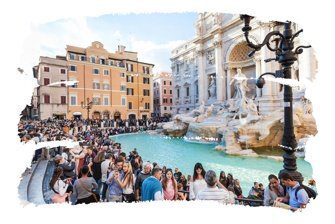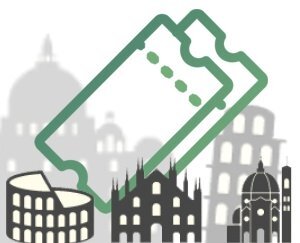Where to watch an opera in Italy?
Today we are going to talk about theaters in the main cities in north-central Italy: Rome, Venice, Milan, Florence and Verona! Let’s see what they are? Where to watch an opera in Italy? Here at Your Travel to Italy with Ana Patricia you make the trip of your dreams!!! ALSO: see our “Accommodation in Italy – Tips for your holidays!”
Introduction
Theater shows in Italy emerged with the Etruscans (who inhabited central Italy before the beginning of the Roman Empire) who originally performed ‘rituals’ during funerals to please the gods; at first, the rituals were performed in the open and around 145 BC, the theater as we know it today began to take shape. The first step for the current format was to place chairs for the audience to sit on, then they wanted to improve the acoustics and, with that, the architecture of the places where the shows happened were taking shape.
1) Where to watch an opera in Italy? IN ROME
Now let’s get to know some theater options in Rome!
Teatro Argentina (Argentina Theater) and Theater Museum
Teatro Argentina – one of the most beautiful Roman theaters! The theater receives mainly opera performances, symphonies, prose readings and classical artists. It is also there that the Theater Museum is located (visit only by reservation via email). Teatro Argentina, also Teatro di Roma, was also known as Teatro Stabile della Capitale, in 1964. In 1972, it restored the historic headquarters of the Theater and gave Teatro Stabile its definitive name, Teatro di Roma, to later be called Teatro Argentina.
Teatro dell’Opera di Roma (Teatro Constanzi)
Teatro dell’Opera di Roma (Teatro Constanzi) – the Teatro dell’Opera di Roma (Rome Opera House) is a theater dedicated to opera and ballet; it is also known as Teatro Costanzi (Constanzi Theater), because of its architect, Domenico Costanzi. The theater was not large (1,100 seats), but it had excellent acoustics and a beautiful dome painted by Annibale Brugnoli. In 1926, the Municipality of Rome bought the theater and took over its management.
A little of its history
It was closed on November 15th, 1926 so that improvements could be made. Entirely external elevations were redone, increasing one of the three orders of original boxes. An impressive crystal chandelier, six meters in diameter, three and a half meters high, was installed , three tons of weight, thirty-six cubic meters of volume and 27 thousand prismatic crystals of Bohemia arranged in 560 vertical stripes. The chandelier also has 270 lamps used to shine the crystals and 18 thousand watts of energy needed to turn them on .
This chandelier is the largest in Europe and every five years this monumental Murano viticulture masterpiece is placed on the floor by a winch and subjected to a complete check-up and a detailed and delicate cleaning. In 1930, the organ company Buccolini set up a pipe organ with a keyboard and pedalboard, hidden to the right of the stage by an expressive grid. In 1956, the Municipality of Rome requested the operation of extension and restoration of the theater.
The work foresaw, among other things, the creation of a grand staircase and an entrance hall for the boxes of office space and the installation of new furniture; the renovation of the facade, in the style of the 20th century, was completed in 1960. Nowadays the Rome Opera House has a capacity of about 1400 people.
2) Where to watch an opera in Italy? VENICE
Now let’s see some theater options in Venice!
Teatro La Fenice (La Fenice Theater)
Teatro La Fenice – besides being one of the most beautiful, traditional and famous in Italy, it is one of the oldest! If you are passionate about operas, you will fall in love, and if you are not, you will also fall in love with this magnificent theater. The Teatro La Fenice was opened in 1792 and is a mandatory stop in Venice. It underwent its first restoration in 1825 and in 1836 it was almost destroyed by fire. After a new renovation, it was reopened once in 1837 and once in 1854, when a new decoration was made on the ceiling of the theater. After a great fire that almost completely destroyed it, in 1996, the theater was restored again and returned to its 18th century splendor. The theater is stunningly beautiful and attracts because of its unique and special history! To visit the theater it is necessary to make an advance reservation, to check schedules, click here!
Teatro Stabile di Veneto Carlo Goloni
Teatro Stabile di Veneto Carlo Goldoni – another historic and beautiful theater in Venice is the Teatro Goldoni. Opened in 1992, the theater hosts operas, ballets, plays and other performances. The Goldoni Theater is the oldest and still existing in Venice. It was built by the Vendramin family in 1622 and called by its name. In 1653, the theater was destroyed by a violent fire and the new owners, Andrea and Zanetta Vendramin, decided to rebuild it.
A little history of the theater
In the short term of French domination, in 1807, the Ministry of the Interior reduced the city’s theaters, which could only be used in proportion to the population density. The Venetian theaters were reduced to four, one of which was closed! Within the reason for its closure, they say, there are political motivations: it would be a punishment for the Vendramins family who were suspected of sympathizing with the Austrians. In 1815, when the Austrians returned, an imperial decree restored the possibility of reopening to the theater, and this officially happened in 1817, after a radical structural renovation.
Theater Expansion
In 1833 the foyer was enlarged, the stage lengthened and the curve of the theater was adjusted; in 1836, with the destruction by the fire at the Teatro La Fenice, the Vendramins accepted to receive the shows of the burned theater. Only one La Fenice show was canceled: a ballet show, because the stage of the Teatro Goldoni was too small to receive it. During the painful years of World War II, June 15, 1947, the theater was considered unusable and was permanently closed because of the unsafe structural conditions that needed almost complete reconstruction after bombings.
Political problems
In that summer of 1947, the former Teatro Goldoni suffered several coups d’état. Lawyer Baldissera and the municipal administration decreed that the building was a community benefit and on October 5th, 1957, the municipal administration purchased the building, but the problem was finding the money needed to proceed with the purchase and restructuring. The impasse seems to have been broken through a Giorgio Foundation project, but it was not followed up. It was considered a partial demolition of the building and the preservation of some structures.
The works began only in the summer of 1969: a completely new building was built and its external structures were completed in 1973. Finally, on April 22nd, 1979, and with a total expenditure of almost three million pounds (former Italian currency), the theater was reopened, nineteen years later in relation to the first project, twenty-nine years after the acquisition by the municipality and thirty-two years after its closure.
The Municipality of Venice managed the theater for many directors, until 1992, when management was introduced at the Teatro Stabile del Veneto, an association that also covers the Teatro Giuseppe Verdi, in Padua. Visits only by appointment by e-mail; you can access the page by CLICKING HERE!
3) Where to watch an opera in Italy? MILAN
Now let’s see some options of theaters in Milan!
Teatro alla Scala (La Scala Theater)
Teatro alla Scala – it is undoubtedly one of the best-known theaters in the world. Some documents show that the first structure of the place was erected in 1381, and it was a church. Other documents say that it was already a theater, and the structure was demolished in 1774, by order of Empress Maria Tereza D’Austria, who wanted to replace the old theater that, they say, was there, called Regio Ducale. Others say that a fire destroyed the old theater and that, in 1776, the Emperor ordered a new theater. To find out more about Teatro alla Scala click here!
Anyway, officially, La Scala was inaugurated on August 3rd, 1778 with the operation of Antonio Salieri, ‘L’Europa Riconosciuta’. During the war, the theater was bombed and, in May 1946, the theater was reopened ‘as it was and where it was’! Today it is a splendor and presents several types of shows. To visit it, I suggest you buy the ticket online by clicking here!
Teatro Verdi Milano (Verdi Milano Theater)
Teatro Verdi Milano – the 1913 hall features stucco moldings and their original design features. Teatro Verdi has constantly reinvented itself over the years and has also become a recording studio, billiard room and ballroom – well known in the post-war years – until the 1970s. Since 1975 it has been managed by Teatro del Buratto , as the headquarters of its varied productions and programs, which in recent years has also seen the prestigious IF – International Theater Festival image and form, becoming a significant theater place in Milan.
A little history of the theater
The Verdi Theater is a collection room that keeps its charm simple and intact, thanks to a careful restructuring that took place in the late 1980s. The wooden stage and the velvet armchairs make the space an excellent place to be; creative design is an authentic synthesis of hospitality and productivity, suitable for holding shows, book presentations, company meetings and training sessions. Very multipurpose! It is not open for visits, but there are different types of shows. To find out what they are and buy tickets, click here (when searching, write Teatro Verdi Milano).
4) Where to watch an opera in Italy? VERONA
Now, let’s get to know some theater options in Verona!
Arena di Verona (Verona Arena)
Arena di Verona – It is not just a theater, it is a masterpiece, one of the most beautiful monuments in the city! The Arena amphitheater was built in the first half of the 1st century AD. The façade was originally made of limestone, white and pink, from Valpolicella. After an earthquake in 1117, the building’s outer ring was almost destroyed, with the exception of the area called the Wing. The Arena was used as a quarry for the construction of other buildings. The first restoration interventions took place in the Renaissance era and aimed to restore the Arena’s functionality for artistic presentations. Thanks to its impressive acoustics, the Arena of Verona is an excellent venue for concerts, which began in 1913. Currently, the venue is the stage for operas and performances by big names in music and the national and international spectacle. To buy tickets for the various shows, click HERE!
Teatro Nuovo di Verona (New Verona Theater)
Teatro Nuovo di Verona – in addition to presenting incredible shows, the theater also has theater classes given by big Italian names. The company was born in 1989, so it is one of the newest theaters in the city, but it has already established itself as one of the best. The theater also has movie theaters for adults and children, and several cultural events. To request a visit, you must send the request by email; for contact information click here!
5) Where to watch an opera in Italy? FLORENCE
Now, let’s get to know some theater options in Florence!
Teatro Della Pergola (Pergola Theater)
Teatro Della Pergola – The theater was built in 1656 by Ferdinando Tacca (son of the sculptor Pietro Tacca). It opened in 1657, with the premiere of the opera ‘Il podestà di Colognole’, by Jacopo Melani. Although it has been in operation since 1657, the works were completed in 1661, when the theater celebrated the wedding of the future Grand Duke Cosimo III with Margherita Luisa d’Orléans, presenting the ‘Ercole in Tebe’ show, by Melani, as a ‘gift’.
A little history of the theater
Considered the first major ‘layered’ theater; for the first time, the oval shape was also tested for better acoustic performance. The theater, which later became ‘Grand Ducale, underwent several changes, such as the closing of the column space in 1688. However, the most important intervention was between 1753 and 1755, when a project by Giulio Mannaioni remade the wooden structures of the hall, which was considered dangerous since the lighting was done by candles, which considerably increased the risk of fire.
In 1789, again according to the Mannaioni project and the work direction of Luca Ristorini, a fifth order of boxes was added to the audience. In 1800-1804, based on a design by Ristorini and under the direction of the architect Giuseppe Salvetti, the ‘music hall’ was called ‘il saloncino’ (in free translation, ‘the little room’); at the same time it was built in the building on the east side of the theater. The current forms, however, are substantially due to the interventions of Bartolomeo Silvestri made between 1820 and 1828. In 1834, Antonio Meucci, a Pergola mechanic, installed the first acoustic ‘telephone’ in history (mechanical transmission, not yet electrical), to communicate between the various rooms of the theater.
Theater Reform
Between 1855 and 1857, Gaetano Baccani reformed some areas of the theater again, including new rooms and dressing rooms. In 1942, other reforms and adaptations were carried out to make the theater conform to technical and safety standards. In 1948-1949, the theater underwent a major restoration project by architect Nello Baroni and engineer Simonetti, with the total renovation of the furniture and the transformation of the main stage.
After the damage caused by the 1966 flood, the building was then the subject of a complex structural restoration project designed by the architect Luigi Caliterna; the wooden trusses on the roofs of the room and the stage were replaced with steel trusses, in addition to reinforcing the consolidation of foundations and support walls to prevent a possible fall.
Reopening
In December 1967, already reopened, Pergola continued its intense and qualified theatrical activity until the 1980s. Once again, to adapt to the new public space security laws, several areas of the theater were renovated between 1984 and 1988. Nowadays, with the recovery of the theatrical activity of the Saloncino and other rooms under the public floor, the theater expanded its potential. Since June 2010, the Ministry of Cultural Heritage (Mibac) has administered it. It is not possible to visit the theater, but there are several shows; to buy tickets or request information, click here!
Teatro Verdi Firenze (Verdi Firenze Theater)
Teatro Verdi Firenze – The former Pagliano Theater received this name in 1901. In the past, there used to be a jail and the old theater was opened in 1854! With an oval plan and incredible acoustics, the theater is the stage for several shows. Between 1949 and 1950, the theater underwent a complete renovation and, since then, it has received numerous artistic shows from different segments. To see the full schedule and buy tickets, just click here!
Watch this video and learn: For which monuments in Italy should I buy the ticket in advance?
Subscribe to our channel and receive more videos with information and tips about Italy. Don’t forget to leave that Like;)
Conclusion
Where to watch an opera in Italy? Italian theaters and shows impress, delight and undoubtedly deserve special attention! And if you feel insecure or have no time, and need help to organize your trip, do not hesitate to look for me! I will love to help you make your dream trip to Italy. And how can I do that? Continue reading this post until the end and you will understand how can we make your life and journey easier.
Did my post help you? If yes, make sure to leave your comment below, but if you still have questions, just leave them as a comment below and I will reply, O.K.?
An Extra Help for your Trip
The best content from Your Travel to Italy!
Learn more about our tours in Italy right now!
- What to visit in Italy in 10 days?
- The ten must-see places in Tuscany?
- The best tips to save on your trip to Italy?
- What are the 10 most visited cities in southern Italy?
- Airports in Italy? How to get to your hotel? (Venice, Milan, Rome, Florence)
- What to do in 1/2/3/4 days in the main Italian cities?
- The best tips on food in Italy (wines, typical food, enogastronomy tours)
- How to get from Fiumicino Airport to Rome downtown?
- Your Travel to Italy: 10 tips for traveling through Italy!
Best regards from Italy




 Save money!
Save money!